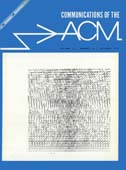October 1970 - Vol. 13 No. 10

Features
Transition network grammars for natural language analysis
The use of augmented transition network grammars for the analysis of natural language sentences is described. Structure-building actions associated with the arcs of the grammar network allow for the reordering, restructuring, and copying of constituents necessary to produce deep-structure representations of the type normally obtained from a transformational analysis, and conditions on the arcs allow for a powerful selectivity which can rule out meaningless analyses and take advantage of semantic information to guide the parsing. The advantages of this model for natural language analysis are discussed in detail and illustrated by examples. An implementation of an experimental parsing system for transition network grammars is briefly described.
A formalism for translator interactions
A formalism is presented for describing the actions of processors for programming languages—compilers, interpreters, assemblers—and their interactions in complex systems such as compiler-compilers or extendible languages. The formalism here might be used to define and answer such a question as “Can one do bootstrapping using a metacompiler whose metaphase is interpretive?” In addition an algorithm is presented for deciding whether or not a given system can be produced from a given set of component processors.
The use of interactive graphics to solve numerical problems
With the advent of on-line (time-sharing) computer systems and graphic terminals, we have available a new dimension in numerical problem solving capabilities. Rather than simply use the new power to achieve fast turnaround, we can develop interactive routines which are easy to use and also take advantage of the insight and visual capabilities of the human problem solver. Several on-line systems for general purpose mathematical problem solving have already been implemented as well as some special purpose systems for solving problems in a particular area such as ordinary differential equations. The advantage of restricting the problem area is that the interface with a user can be greatly simplified. In this paper we discuss some of the advantages accrued by such systems and design considerations for interactive routines. Furthermore, an implmentation of an on-line least squares data-fitting program, PEG, is presented with results obtained from empirical data. In conclusion, areas for future work in this field are discussed.



